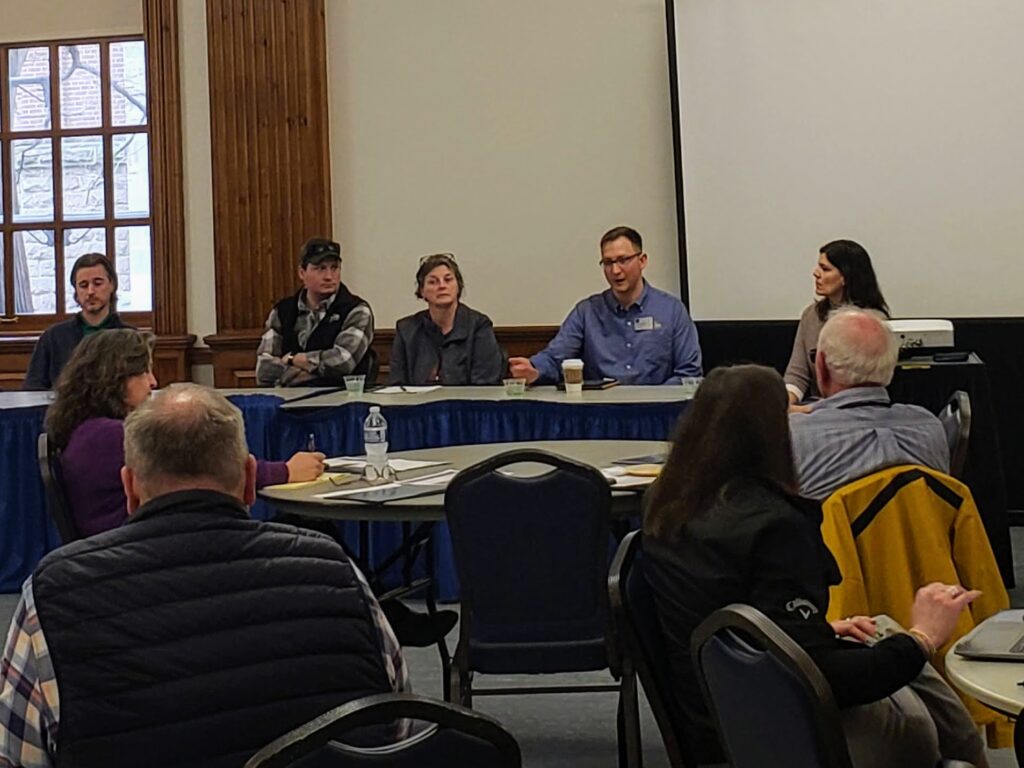The Illinois Sustainable Ag Partnership (ISAP) gathered experienced drainage engineers and technical service providers to offer A Practitioner’s Guide to Advancing Conservation Drainage Practices. The half-day training was held Wednesday, April 2, 2025, in conjunction with the Conservation Drainage Network’s 2025 Annual Meeting at the Illini Union Hotel on the Urbana campus of the University of Illinois.
The focus of the event was on edge-of-field practices that remove excess nutrients from sub-surface tile drainage water: drainage water management, constructed wetlands, saturated buffers, and woodchip bioreactors. These practices are vitally important components of our drainage infrastructure in Illinois and in other areas with poorly drained soils.

Megan Baskerville, The Nature Conservancy (far right), moderated the Selling Conservation Drainage Practices panel discussion. Other panelists included from left to right, Justin McBride P.E., H2Ohio Engineering Manager, Ohio Department of Agriculture; Dallas Glazik, Precision Ag and Conservation Specialist, Pheasants Forever, Inc. and Quail Forever, Illinois; Jean McGuire, Field Outreach Specialist, The Wetlands Initiative; and Caleb Rasmussen, P.E., Civil Engineer, ISG, Inc. (Photo by Adrienne Marino, The Nature Conservancy)
“Through this training, ISAP’s goal was to provide conservation professionals with practical knowledge and tools needed to identify high-quality potential sites for conservation drainage practices and to feel more confident discussing these practices with farmers and landowners,” said Adrienne Marino, coordinator of the ISAP Edge-of-Field Working Group, which planned the event. “The training participants benefitted from the wide range of expertise on hand due to the collaboration with the Conservation Drainage Network.”
Experts shared information on key steps for assessing a site’s suitability for one or more conservation drainage practices. The second portion of the program outlined how to manage the design and implementation of the practices. The training concluded with a panel discussion, which included several practitioners sharing approaches and techniques they use to advocate for increased edge of field practice adoption and implementation.

Dr. Jill Kostel, Water Resources Program Director, The Wetlands Initiative, presents at the Practitioner’s Guide to Advancing Conservation Drainage Practices. (Photo by Adrienne Marino, The Nature Conservancy)
In addition, the ISAP planning team pulled together The Conservation Drainage Toolkit folder to share materials that attendees can use in their ongoing work to advocate for and implement these practices.
ISAP has assembled a dynamic set of resources designed to assist users in their work to promote conservation drainage practices. As new resources are developed, they will be added to the toolkit. To suggest additional resources, please contact ISAP (hello@ilsustainableag.org).
Support for the training was provided through a grant from the Foundation for Food and Agriculture Research (FFAR).
Planning Team – Members of ISAP Edge of Field Working Group
Adrienne Marino (TNC) – Coordinator
Jill Kostel (TWI)
Ryan Arch (IL LICA)
Keegan Kult (ADMC)
Megan Baskerville (TNC)